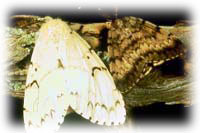

The gypsy moth (Lymantria dispar, L.) was introduced in the United States from Europe in the mid 1800's (Campbell, 1979). By the 1990's the moth was found throughout the Northeast, mid-Atlantic regions, Michigan and eastern Wisconsin. Caterpillars and egg masses are spread on recreational vehicles, cars, nursery stock, firewood, and outdoor furniture (Brooks & Hall, 1997).
Gypsy moths prefer oaks, aspen, basswood, willow, tamarack, birch (white and gray), apple, hawthorn, witch hazel, and alder. They defoliate hardwood trees, but also feed on some conifers (Witter et. al., 1992). The heaviest defoliation occurs from June to early July. Most healthy trees can withstand one or two years of defoliation (Brooks and Hall, 1997).
However, gypsy moth defoliation can make a tree more susceptible to attack by secondary organisms, such as the two-lined chestnut borer and shoestring root rot. Both secondary organisms often attack and kill defoliated trees. While healthy trees can tolerate or resist attacks by secondary organisms, trees in poor health are at greater risk of death from attack (Gottschalk, 1993).
There are three primary management strategies available to manage a forest stand with gypsy moths:
Campbell, R.W. 1979. Gypsy moth: Forest influence. USDA Agric. Inf. Bull. No. 423. 44pp.